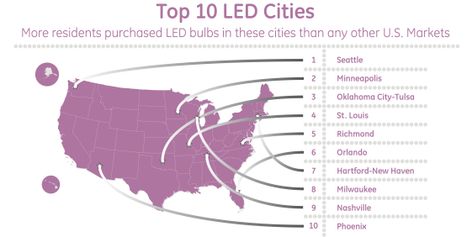Top 10 Cities Reaping Benefits of LED Adoption

- Seattle, Minneapolis, Oklahoma City lead LED adoption with a greater percentage of residents purchasing LEDs for their home than other major U.S. cities
- In top cities, one-third of residents have purchased at least one LED, still leaving two-thirds of homeowners missing out on LED benefits
CLEVELAND, Ohio, April 5, 2017 – Cities like Seattle, Minneapolis and Oklahoma City are leading the charge and reaping the benefits when it comes to LED adoption, but there is still a long runway. Less than 20 percent of U.S. residential light sockets contain an LED bulb, which means millions are missing out on this high-quality, energy-saving light source.
Changing just one 60-watt light bulb to an LED could save as much as $130 in energy costs over the bulb’s life, enough to buy 40 extra lattes, cover 16 trips to the movies or pay for other fun treats.1 It typically costs $5 or less to make the switch and help leave a positive impact on the environment, and as Earth Day approaches, there has never been a better time to commit to LED.
Top 10 LED Cities
These cities are leaders in LED adoption, impacting the environment and shaving energy use and costs at home. Cities are ranked by percentages of residents who have purchased at least 1 LED bulb over the last year.
- Seattle, WA – 35.5%
- Minneapolis, MN – 32.9%
- Oklahoma City/Tulsa, OK – 32.3%
- St. Louis, MO – 32.2%
- Richmond, VA – 30.5%
- Orlando, FL – 30.1%
- Hartford/New Haven, CT – 30%
- Milwaukee, WI – 29.3%
- Nashville, TN – 29.2%
- Phoenix, AZ – 28.8%
Environmental Benefits
LEDs are 70 to 90 percent more efficient than traditional light sources, leaving a big impact on the environment. If every American switched out one 60-watt traditional bulb with an ENERGY STAR® LED bulb3:
- We’d eliminate seven billion pounds of greenhouse gas emissions. That’s equivalent to removing the emissions from 648,000 cars.
- We’d save $566 million in annual energy costs. That’s enough to light 2.6 million homes for a year.
Personal Savings Benefits
Switching every bulb at home to an LED could save about $6,000 over the life of the bulbs.4 That’s enough for a great vacation, but even swapping one bulb makes a difference. By switching just one 60-watt traditional bulb to an LED bulb1:
- You’d save enough energy to power nearly 200 episodes of your favorite hour-long TV show.
- You could microwave 3 two-minute meals per day for an entire year.
- You could see your baby off to college. LEDs generally last 13-22 years (based on 3 hours per day use), which means if you installed an LED in your newborn’s room it could still be running strong by the time you send her off to college or even celebrate her graduation.
Jumpstart Your LED Journey
Throughout the month of April, GE is encouraging consumers to make a pLEDge to switch even just one traditional bulb to an LED bulb. To help, GE is offering printable LED coupons in conjunction with the pLEDge, as well as a Facebook sweepstakes that’ll earn one lucky winner a whole-home LED makeover. The sweepstakes also includes weekly giveaways of retailer gift cards.
For more information, visit www.GELighting.com/pLEDge.
About GE
GE (NYSE: GE) is the world’s Digital Industrial Company, transforming industry with software-defined machines and solutions that are connected, responsive and predictive. GE is organized around a global exchange of knowledge, the "GE Store," through which each business shares and accesses the same technology, markets, structure and intellect. Each invention further fuels innovation and application across our industrial sectors. With people, services, technology and scale, GE delivers better outcomes for customers by speaking the language of industry. www.ge.com
1 Based on using a 25,000-hour life, 60-watt, ENERGY STAR® LED bulb for 3 hours per day
2 Nielsen Homescan Data
3 ENERGY STAR® Environmental Statistic
4 Based on using 45, 25,000-hour life, 60-watt, ENERGY STAR® LED bulbs for 3 hours per day over 22.8 years
